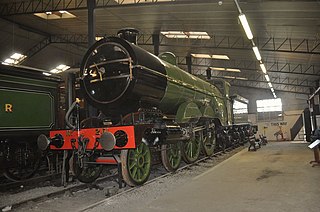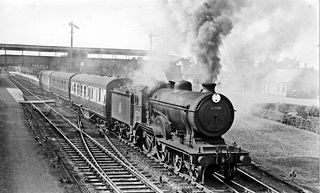
The London and North Eastern Railway (LNER) Class O4 initially consisted of the 131 ex-Great Central Railway (GCR) Class 8K 2-8-0 steam locomotives acquired on grouping in 1923. The engines were designed by John G. Robinson and built at the GCR's Gorton Locomotive Works, Manchester.

The NBR C Class is a class of 0-6-0 steam locomotives designed by Matthew Holmes for freight work on the North British Railway (NBR). They were introduced in 1888 with inside cylinders and Stephenson valve gear. A total of 168 locomotives was built, of which 123 came into British Railways ownership at nationalisation in 1948. This was the last class of steam engine in service in Scotland.

The London and North Eastern Railway Class J38 was a class of steam locomotive designed for freight transport. They were designed by Nigel Gresley and introduced in 1926. A total of 35 were built at the LNER's Darlington Works in 1926 and they were used in Scotland. All passed into British Railways ownership in 1948 and they were renumbered from 5900–5934 to 65900–65934.

The Great Northern Railway 521 Class was a class of 0-6-0 steam locomotives, introduced in 1911. They were designed by Henry Ivatt for goods traffic. From 1912 to 1922 further examples, slightly modified by Nigel Gresley, were built and designated 536 Class. The most obvious difference was in the front sandboxes. These were below the running plate on the 521 but above it and merged with the front splashers, on the 536. The boiler and firebox were also moved back, thus resulting in a shortened cab. The London and North Eastern Railway classified them both as J6.

The North Eastern Railway Class S3, classified B16 by the LNER, was a class of 4-6-0 steam locomotive designed for mixed traffic work. It was designed by Vincent Raven and introduced in 1920. The earlier members of this class were fitted with Westinghouse Brakes - all of this equipment was removed during the 1930s.

The Great Northern Railway Class H4 was a class of 2-6-0 steam locomotive designed for mixed-traffic work.
Edward Thompson was an English railway engineer, and was Chief Mechanical Engineer of the London and North Eastern Railway between 1941 and 1946. Edward Thompson was born at Marlborough, Wiltshire on 25 June 1881. He was the son of Francis Thompson, assistant master at Marlborough College. He was educated at Marlborough before taking the Mechanical Science Tripos at Pembroke College, Cambridge, earning a third class degree. Thompson entered the railway scene after education, contrasting that of his predecessor Nigel Gresley, who had also attended Marlborough after gaining practical experience as a pupil at Horwich Works.

The Great Northern Railway Class J23 was a class of 0-6-0T steam locomotive. They had long side tanks that came to the front of the smokebox, which sloped forwards to improve visibility and had a recess cut in to aid maintenance. Forty were built by the Great Northern Railway (GNR) between 1913 and 1922, with a further 62 being added by the London and North Eastern Railway (LNER) between 1924 and 1939. They were given the nickname "Submarines" due to their long tanks.

The London and North Eastern Railway (LNER) Class B17, also known as "Sandringham" or "Footballer" class was a class of 4-6-0 steam locomotive designed by Nigel Gresley for hauling passenger services on the Great Eastern Main Line. In total 73 were built.

The London and North Eastern Railway Class U1 was a solitary 2-8-0+0-8-2 Garratt locomotive designed for banking coal trains over the Worsborough Bank, a steeply graded line in South Yorkshire and part of the Woodhead Route. It was both the longest and the most powerful steam locomotive ever to run in Britain. It was built in 1925 with the motion at each end being based on an existing 2-8-0 design. The original number was 2395, and it was renumbered 9999 in March 1946, and then 69999 after nationalisation in 1948, although it retained its cab-side plate bearing its original number throughout its life. The locomotive ran for some time as an oil burner, and was tried out on the Lickey Incline in 1949–1950 and again, after the electrification of its home line, in 1955. These trials were unsuccessful, and so the locomotive was withdrawn in 1955 and scrapped.

The LNER W1 No. 10000 was an experimental steam locomotive fitted with a high pressure water-tube boiler. Nigel Gresley was impressed by the results of using high-pressure steam in marine applications and so in 1924 he approached Harold Yarrow of shipyard and boilermakers Yarrow & Company of Glasgow to design a suitable boiler for a railway locomotive, based on Yarrow's design.

The Great Northern Railway (GNR) Class C1 is a type of 4-4-2 steam locomotive. One, ex GNR 251, later LNER 2800, survives in preservation. Much like their small boiler cousins, they were capable of reaching speeds of up to 90 mph (145 km/h). They were also known as Large Atlantics.

The GER Classes S46, D56 and H88 were three classes of similar 4-4-0 steam locomotive designed by James Holden and A. J. Hill (H88) for the Great Eastern Railway.

The first London and North Eastern Railway (LNER) Class A2 was a class of 4-6-2 steam locomotive designed by Vincent Raven for the North Eastern Railway. Two were built by the NER in 1922 before the grouping and another three by the LNER in 1924. Their LNER numbers were 2400–2404. All five locomotives were named by the LNER.

The Great Northern Railway Class H2 and H3 was a class of 2-6-0 steam locomotive designed for mixed-traffic work.

The London and North Eastern Railway (LNER) Class V1 and Class V3 were two classes of related 2-6-2T steam locomotive designed by Sir Nigel Gresley. A total of 82 V1s were built with 71 being rebuilt into the higher pressure V3s with an additional ten being built as V3s from the final batch of V1s. The V3 was a development of the V1 with increased boiler pressure and a resultant increase in tractive effort.
The London and North Eastern Railway (LNER) inherited several styles of coaching stock from its constituents. Sir Nigel Gresley continued the styles that he had established pre-grouping at the Great Northern Railway (GNR) and for the East Coast Joint Stock.
The London and North Eastern Railway (LNER) operated various classes steam locomotives with a 4-6-2 wheel arrangement. The LNER operated more pacifics than any other of the Big Four British railway companies, and they were mostly used for express passenger work along the East Coast Main Line, though later in their lives many were displaced to other lines.

The Great Northern Railway J4 Class was a class of 322 0-6-0 steam locomotives, introduced in 1882 designed by Patrick Stirling for goods traffic. Just over half of these were rebuilt by Nigel Gresley to a design by Henry Ivatt between 1912 and 1929.
The GNR Classes D2 and D3 were two classes of 51 4-4-0 steam locomotives designed by Henry Ivatt for the Great Northern Railway (GNR). They were the first 4-4-0s to be introduced by the GNR, and Ivatt's first original design for the railway as well.


















